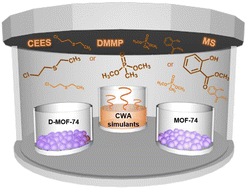Defective MOF-74 with ancillary open metal sites for the enhanced adsorption of chemical warfare agent simulants†
Abstract
The development of effective porous adsorbents plays a vital role in eliminating hazardous substances from the environment. Toxic chemicals, including chemical warfare agents (CWAs), pose significant risks to both humans and ecosystems, highlighting the urgency to create efficient porous adsorbents. Therefore, substantial attention has been directed towards advancing adsorption techniques for the successful eradication of CWAs from the environment. Herein, we demonstrate a rational approach for enhancing the adsorption capability of a porous metal–organic framework (MOF) by employing ancillary open metal sites within the MOF structure. To generate defective MOF-74 (D-MOF-74) with ancillary open metal sites, some of the 2,5-dihydroxy-1,4-bezenedicarboxylic acid (DHBDC) linkers originally present in the MOF-74 structure were replaced with 1,4-benzenedicarboxylic acid (BDC) linkers. The absence of hydroxyl groups in the BDC linkers compared to the original DHBDC linkers creates ancillary open metal sites, which enhance the adsorption ability of D-MOF-74 for CWA simulants such as dimethyl methyl phosphonate, 2-chloroethyl ethyl sulfide, and methyl salicylate by providing effective interaction sites for the targeted molecules. However, excessive creation of open metal sites causes the collapse of the originally well-developed MOF-74 structure, resulting in a substantial reduction in its empty space and a subsequent decline in adsorption efficiency. Thus, to produce a defective MOF with the best performance, it is necessary to replace an appropriate amount of organic linker and create suitable open metal sites. Moreover, D-MOF-74 displays excellent recyclability during consecutive adsorption cycles without losing its original structure and morphology, suggesting that D-MOF-74 is an effective and stable material for the removal of CWA simulants.



 Please wait while we load your content...
Please wait while we load your content...